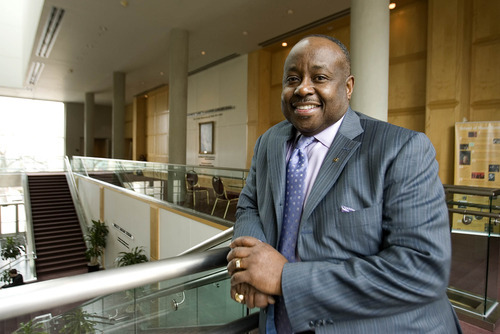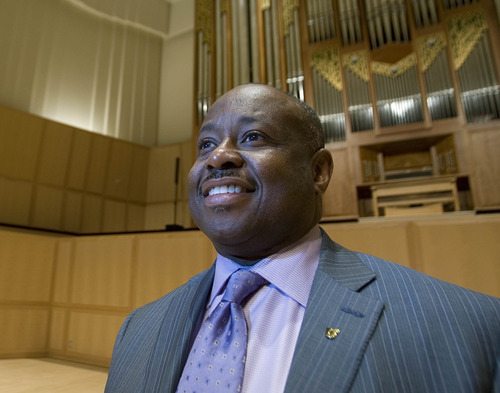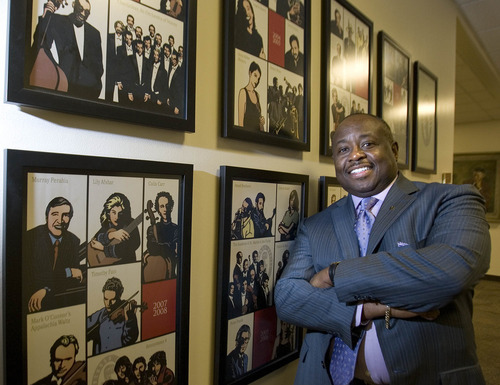This is an archived article that was published on sltrib.com in 2012, and information in the article may be outdated. It is provided only for personal research purposes and may not be reprinted.
Raymond Tymas-Jones wants every University of Utah student to enjoy artistic events on campus, not just those majoring in the arts — fine, liberal or otherwise. Yet he also hopes Utah becomes a destination for the nation's most serious arts students, whether they dance, act, sculpt, make films or play marimba.
"The fine arts and humanities are paramount to the success of the institution to produce world citizens, and that doesn't come about by purely studying hard sciences and business. It's a combination," says Tymas-Jones, dean of the College of Fine Arts and a tenor with years of teaching, operatic performance and choral conducting on his résumé.
Under one of his initiatives implemented this year, U. students receive free admission to dozens of college-sponsored performances and exhibitions each semester. Of course, student fees were bumped up $5 a semester to subsidize the program. While that fee hike drew criticism in a recent legislative audit, the $16 paid annually for the arts is a bargain compared with the $164.72 students pay to subsidize athletics.
Tymas-Jones himself is headlining such an event Feb. 19, celebrating the writer Langston Hughes as part of Black History Month. He will be singing Hughes' poems set to music with an interdisciplinary ensemble.
Opportunities for cultural enrichment in the next few weeks include the Irish accents of the touring Celtic Nights concert, the Mozart opera "Don Giovanni," the play "Emma," based on the Jane Austen novel, Joe Goode Performance Group, and a student production of the play "Rare Bird," which happens to star longtime U. theater professor Anne Cullimore Decker, in the Babcock Theatre.
"For Raymond to do that, it was ingenious and we're getting butts in the seats," Decker says. "It should be the students who are there. Not only has the quality of Babcock performances gone up, but students come free now, which allows them to take a chance when they would otherwise say, 'I can't afford that.' "
Complete numbers are not available, but the college says hundreds of students took advantage of the program last semester. Nearly 500 attended the Babcock performance of "A Midsummer Night's Dream," while 800 students attended two major ballet events.
—
Musical home • Tymas-Jones grew up in the Washington, D.C., area, in a home where all the children learned to sing. His mother was a pianist, while his dad, a minister, could hardly sing a note. Tymas-Jones took up piano and trombone, but when he entered college at Howard University, he was interested in choosing a major that would help him earn a living, leaning toward biology or business.
Instead, he embraced a music major, with a piano focus. He later switched to voice when he discovered singing was where his talents and interests lay while serving as choir conductor for a church. After college, he landed several operatic roles, but soon was raising his own children, preventing him from pursuing a full-time New York City career.
That's when he switched to academia, beginning at State University of New York, Buffalo, which allowed him to perform and teach. He went on to serve as director of music at University of Northern Iowa, and was the arts dean at Ohio University when the U. recruited him.
Utah didn't hold the racial diversity he was accustomed to, but the state had some winning features. "What is different in Salt Lake City is the embrace of the arts in the culture," Tymas-Jones said. "There is huge appreciation for the participation. It's not just they enjoy the arts, they want to do the arts, and they want their children to do the arts."
But, he finds, some Utahns have problems with the kind of art that serves as a "visceral mirror of life," which can be upsetting. "Sometimes it's a soothing and comfortable experience and sometimes it's so raw, it's provocative and hard to look at, like the movie 'Precious,' " he said. "It had ugly components, but it was real life."
—
Plan for excellence • Tymas-Jones, now in his seventh year as dean and associate vice president for the arts, succeeded Phyllis Haskell, now an emerita professor of modern dance, to become the U.'s first African-American dean. In Utah, he has gained a reputation for speaking out, demanding excellence, making the arts accessible and being a formidable party host with exceptional culinary skills.
Tymas-Jones also has been a force in arts policy, taking a seat on the Utah Arts Council board and becoming president of the International Council of Fine Arts Deans.
"He was very engaged, and very focused on policy issues," said Margaret Hunt, Utah Arts Council director. "He was not afraid to speak his mind. On a board, you want that diverse thinking."
Decker adds: "He is highly motivated, highly energized, always wanting things to change, improve, and he becomes impatient with mediocrity and people who are satisfied with the status quo."
The university is in the process of retooling its undergraduate experience as it prepares to inaugurate president David Pershing, the longtime senior vice president for academic affairs who hired Tymas-Jones. The College of Fine Arts, home base for 2,130 students, expects to play a significant role as part of a strategic plan college faculty and administrators recently crafted.
"The focus is to imagine the possibilities, having an opportunity where your life is engaged on both the right and left sides of brain," Tymas-Jones says. "What the arts do is engage the individual and teach intuition and empathy. Certain elements of problem solving go beyond the facts. One plus one equals two. That's a fact. In problem solving, that element of fact is not enough to come to the best possible answer."
—
New facilities needed • The college houses departments of art and art history, ballet, modern dance, film and media arts, and theater and the School of Music, as well as the Utah Museum of Fine Arts and several performance venues. Its enrollment has swelled by 22 percent since Tymas-Jones' arrival.
"This was during hard economic times — why?" he says. "Once you discover your own voice, who you are at the core, it's very hard to ignore it."
His hope is that the U. will be among the nation's top 20 institutions for undergraduate arts education, serving as a magnet for students who have discovered their voices.
To help achieve this goal, the college has two capital campaigns under way to enhance its nerve center, a concrete complex built in 1970. Tymas-Jones is spearheading efforts to raise $7 million to renovate the former Utah Museum of Fine Arts building, to eventually house the film and digital arts programs, and an additional $5.5 million to build a 10,000-square-foot student art gallery on the west side of the college.
Also on his wish list is a new performance venue for the theater department, which currently has just two stages, the Babcock in the basement of the Simmons Pioneer Memorial Theatre and Studio 115. While the U. has two large professional stages at Kingsbury and Pioneer, the theater department lacks access to an intimate proscenium stage. Tymas-Jones thinks theater students deserve a venue with 300 to 400 seats.
Decker goes even further. "We need a building," she says. "The Performing Arts Building was the geology museum when I went to school way back when. It's a pathetic old building. We've grown since we've returned the musical theater program. The Babcock isn't big enough for musicals. You need fly space for sets."
But a new theater building will take time to develop, as Tymas-Jones and Decker noted that it's hard to compete with the major arts organization for philanthropic dollars, while artists aren't the wealthiest U. alumni.
"People in the arts, unless they made it big in a movie or something, don't have that kind of money," Decker says.
About Raymond Tymas-Jones
Raymond Tymas-Jones is a tenor, cook and dean leading the University of Utah's College of Fine Arts , while serving as associate vice president of the arts. The college has an enrollment of 2,130 majors and houses the departments of art and art history, ballet, modern dance, film and media arts, theater and the School of Music, as well as overseeing the Utah Museum of Fine Arts and several performance venues.













